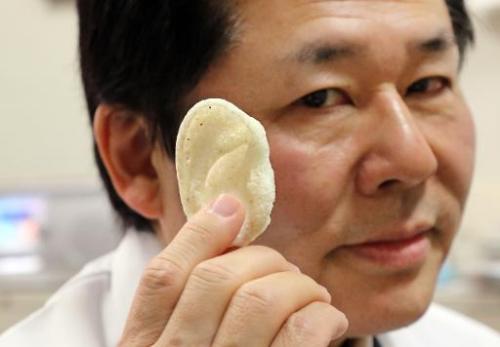
Japanese researchers are focusing on developing ways to 3D print body parts.
Many research labs continue to develop methods of 3D printing living tissue, with the distant goal being the ability to create required body parts on demand.
A common technique is to build a dissolvable “scaffold”, upon which is implanted active cells appropriate to the application. The scaffold is 3D printed in a shape custom-designed to fit the patient, perhaps based on a 3D scan. The cells grow within the scaffold, the scaffold dissolves and there you have a body component of living cells. In the image above, a researcher shows a 3D printed ear made using this technique.
It sounds easy, but it is far from that. There are many issues yet to overcome. For example, the Japanese researchers are trying to avoid heat contamination during extrusion, which can damage the living cells being deposited.
Another issue is the material for the scaffold. To avoid tissue rejection, one typical source is the patient’s own cartilage and bones – but using them means you’re subtracting from the body. By developing new scaffolding materials, this can be avoided.
Different scaffolds must be used for different applications. Bone implants must be made based on rigid scaffolds, while other tissue types must be flexible.
All the materials must not only be bio-compatible, but also be able to encourage the growth of the target cells. It’s going to take much trial and error to discover the right substances.
Today there’s a race among researchers to find the right materials to do these types of prints. Our hope is that the numerous parties around the world working on this problem will soon discover ways to make 3D bio-printing a reality.
Via PhysOrg

